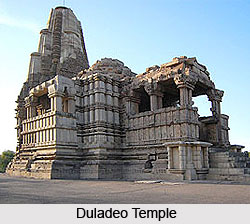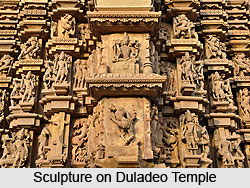 Duladeo temple is dedicated to Lord Shiva and comprises of his beautiful idol. The magnificence of this place can be seen throughout its architecture and craft. This temple is also known as Kunwarnath temple. The temple was built by the rulers of the Chandela dynasty.
Duladeo temple is dedicated to Lord Shiva and comprises of his beautiful idol. The magnificence of this place can be seen throughout its architecture and craft. This temple is also known as Kunwarnath temple. The temple was built by the rulers of the Chandela dynasty.
It is believed that this temple is believed to have been built after the construction of every other temple in Khajuraho. `Maheen` craft has been the main attraction of this temple. Beautiful dancers and other ladies can be seen on the walls. As per evidences Duladeo temple was built around 1130 A.D. It was built by King Madanvarman of the Chandela Dynasty.
The temple consists of an idol of Devi Ganga with four hands. There are different idols in the temple which have been built in various shapes depicting various different stories. The temple has been circularly built and the pillars comprise of drawings of various Apsaras in different dancing forms.

A Shivlinga has been placed in the centre of the temple. There is also an idol of Mahakal which raises the feeling of spirituality in the visiting devotees. Idols of Lord Ganesha and Virbhadra can be seen in the pavilion area of the temple. There are idols of Lord Shiva and Goddess Parvati. The entrance of the temple has idols of Lord Ganesha and Virbhadra.
The temple is also called Kunwar Math. It is nirandhara temple and consists of a sanctum, vestibule, maha-mandapa and porch. As far its plan and in design are concerned it has some features common with the developed medieval temples of the Deccan and western India. Its scheme of ornamentation is typical of temples of Khajuraho. Its sikhara is of the usual developed form, clustered round by three rows of minor sikharas, its maha-mandapa shows peculiarities of design and decoration. The maha-mandapa hall is large and octagonal showing twenty apsaras brackets, grouped in bunch of two or three. The temple Duladeo has many individual features which distinguish it from the rest of the Khajuraho temples. The dancing apsarasas of its interior and the flying vidyadharas on the top row of its facades show vigorous tension and dynamic movement. The plastic treatment has on the whole had been rigid. It lacks depth of relief, which is evident on a majority of the apsaras-figures of the exterior. On the basis of paleography and style the temple can be dated to eleventh century.











